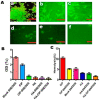A Hyaluronic Acid Functionalized Self-Nano-Emulsifying Drug Delivery System (SNEDDS) for Enhancement in Ciprofloxacin Targeted Delivery against Intracellular Infection
- PMID: 33922241
- PMCID: PMC8146397
- DOI: 10.3390/nano11051086
A Hyaluronic Acid Functionalized Self-Nano-Emulsifying Drug Delivery System (SNEDDS) for Enhancement in Ciprofloxacin Targeted Delivery against Intracellular Infection
Abstract
Ciprofloxacin (CIP), a potent anti-bacterial agent of the fluroquinolone family, shows poor solubility and permeability, thus leading to the development of intracellular pathogens induced multi-drug resistance and biofilms formation. To synergistically improve the biopharmaceutical parameters of CIP, a hyaluronic acid (FDA approved biocompatible polymer) functionalized self-nano emulsifying drug delivery system (HA-CIP-SNEDDS) was designed in the present study. SNEDDS formulations were tested via solubility, droplet size, zeta potential, a polydispersity index, thermodynamic stability, surface morphology, solid-state characterization, drug loading/release, cellular uptake, and biocompatibility. The final (HA-CIP-SNEDDS) formulation exhibited a mean droplet size of 50 nm with the 0.3 poly dispersity index and negative zeta potential (-11.4 mV). HA-based SNEDDS containing CIP showed an improved ability to permeate goat intestinal mucus. After 4 h, CIP-SNEDDS showed a 2-fold and HA-CIP-SNEDDS showed a 4-fold permeation enhancement as compared to the free CIP. Moreover, 80% drug release of HA-CIP-SNEDDS was demonstrated to be superior and sustained for 72 h in comparison to free CIP. However, anti-biofilm activity of HA-CIP-SNEDDS against Salmonella typhi was higher than CIP-SNEDDS and free CIP. HA-CIP-SNEDDS exhibited increased biocompatibility and improved oral pharmacokinetics as compared to free CIP. Taken together, HA-CIP-SNEDDS formulation seems to be a promising agent against Salmonella typhi with a strong targeting potential.
Keywords: anti-bacterial activity; biofilms formation; drug delivery; pharmacokinetics.
Conflict of interest statement
The authors declare no conflict of interest.
Figures








References
-
- Hleba L., Kačániová M., Pochop J., Lejková J., Čuboň J., Kunová S. Antibiotic resistance of Enterobacteriaceae genera and Salmonella spp., Salmonella enterica ser. typhimurium and enteritidis isolated from milk, cheese and other dairy products from conventional farm in Slovakia. J. Microbiol. Biotechnol. Food Sci. 2020;9:1–20.
-
- Arshad R., Pal K., Sabir F., Rahdar A., Bilal M., Shahnaz G., Kyzas G.Z. A review of the nanomaterials use for the diagnosis and therapy of salmonella typhi. J. Mol. Struct. 2021;1230:129928. doi: 10.1016/j.molstruc.2021.129928. - DOI
-
- Wang M., Yang Q., Li M., Zou H., Wang Z., Ran H., Zheng Y., Jian J., Zhou Y., Luo Y., et al. Multifunctional Nanoparticles for Multimodal Imaging-Guided Low-Intensity Focused Ultrasound/Immunosynergistic Retinoblastoma Therapy. ACS Appl. Mater. Interfaces. 2020;12:5642–5657. doi: 10.1021/acsami.9b22072. - DOI - PubMed
Grants and funding
LinkOut - more resources
Full Text Sources

